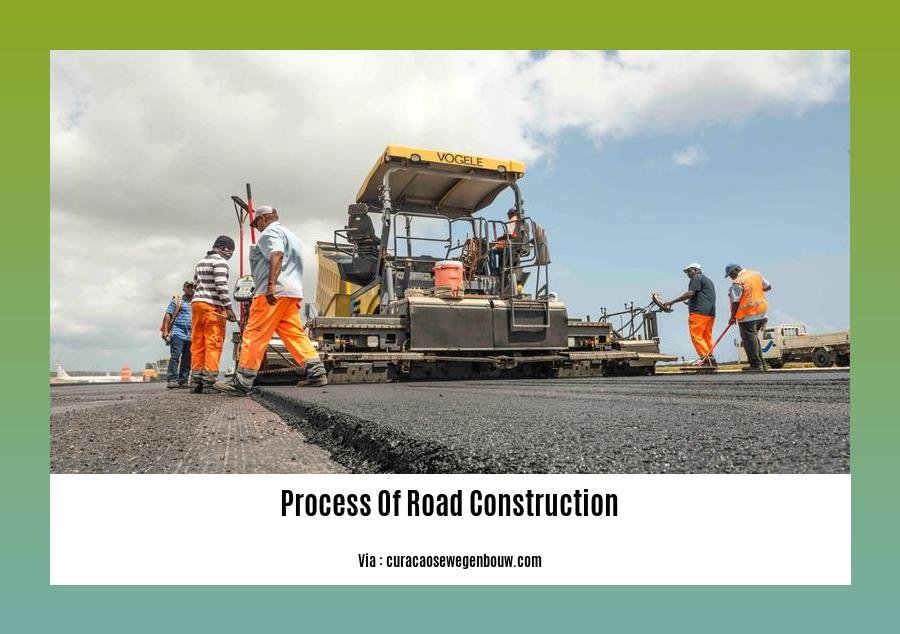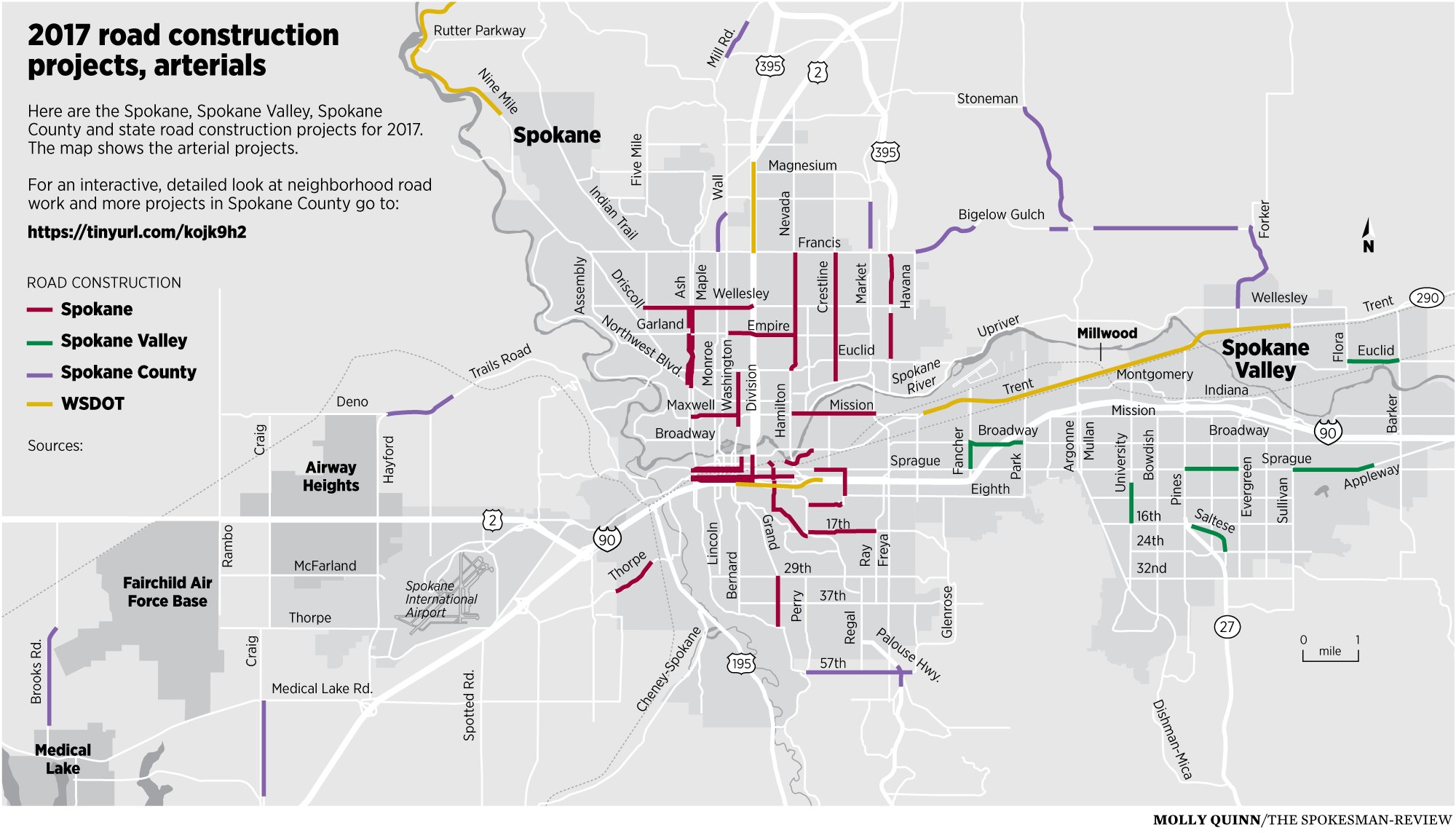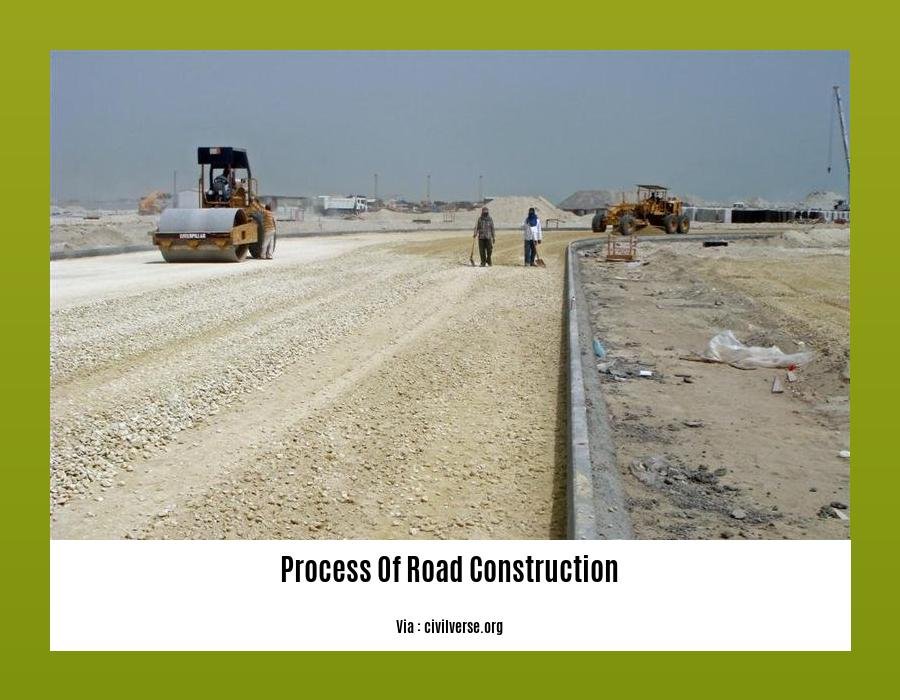Embark on a comprehensive journey through the intricate process of road construction with this insightful guide. From meticulous planning and design to expert execution and rigorous quality control, we delve into the multifaceted world of road infrastructure development.
Key Takeaways:
- Planning: Road construction begins with meticulous planning, design, and budgeting.
- Setting Out: Engineers transfer design plans from drawings to the ground for precise implementation.
- Earthworks: This labor-intensive stage involves clearing vegetation, removing soil and rocks, and building embankments and tunnels.
- Paving: The road surface is constructed using asphalt or concrete.
- Quality Control: Rigorous testing and inspections ensure the road meets safety and durability standards.
Process of Road Construction

The journey of constructing a road, a vital artery connecting communities, involves a meticulous process of road construction. Let’s delve into each phase, from the initial blueprint to the final smooth surface.
Planning: The Blueprint
The groundwork for a road begins with meticulous planning. Engineers survey the terrain, design the route, and estimate costs. They consider traffic patterns, environmental impact, and safety measures to create a blueprint for the road’s existence.
Setting Out: Bringing the Plan to Life
The design transitions from paper to reality in the setting-out phase. Engineers transfer measurements and markings onto the ground, ensuring precise alignment and adherence to the plan.
Earthworks: The Foundation
Earthworks, the most labor-intensive phase, involves reshaping the land. Rocks and soil are removed, embankments built, tunnels dug, bridges constructed, and vegetation cleared. This phase lays the solid foundation for the road.
Paving: The Smooth Surface
After the earthworks, it’s time for the road’s surface. Asphalt or concrete, carefully selected for durability and smoothness, is laid down. The process ensures a safe and comfortable driving experience for years to come.
Quality Control: Ensuring Excellence
Every step of the process of road construction undergoes rigorous quality control. Materials are tested, dimensions are checked, and the finished road is inspected to meet industry standards. This ensures the road’s durability, safety, and adherence to specifications.
Planning to build your dream home? If yes, then you should not miss this article that provides a detailed procurement plan for construction projects.
If you are planning for the procedure of road construction, you will need proper knowledge regarding it.
Are you searching for a genuine company for pro build construction? If so, you are in the right place.
If you are looking for a company for pro built construction inc, we are here to help you.
Searching for experts in pro construction recruitment? We have experts who can help you.
Construction Techniques and Equipment
Delving into the intricacies of road construction, we encounter a symphony of construction techniques and equipment, each playing a crucial role in transforming raw materials into durable and safe thoroughways.
Key Takeaways:
- Road construction involves meticulous planning, precise execution, and rigorous quality control.
- Construction Techniques are the systematic processes used to shape the road, from earthworks to paving.
- Construction Equipment encompasses the machinery and tools employed to execute these techniques efficiently.
- The latest technologies and best practices drive innovation in road construction, enhancing safety and sustainability.
Construction Techniques
- Earthworks: Reshaping the land, sculpting embankments and excavating cuttings, using bulldozers, graders, and compactors.
- Drainage: Controlling water flow and preventing erosion, employing pipes, culverts, and drainage ditches.
- Paving: Laying down asphalt or concrete using pavers, rollers, and finishing machines to create a smooth and durable surface.
- Markings and Safety Features: Installing road signs, guardrails, and delineators to ensure clarity and visibility.
Construction Equipment
- Bulldozers: Heavy-duty earth-moving machines with blades and tracks for clearing land and shaping embankments.
- Graders: Blades used for leveling, profiling, and spreading materials, ensuring a smooth road surface.
- Compactors: Machines that compress soil and materials, creating a solid foundation and reducing potential weak spots.
- Pavers: Automated machines that spread asphalt or concrete, ensuring uniform thickness and a smooth finish.
- Rollers: Heavy cylinders that compact the pavement, enhancing its durability and smoothness.
Conclusion
Understanding construction techniques and equipment provides a glimpse into the complex world of road construction, highlighting the importance of precision, innovation, and rigorous quality control. These factors collectively contribute to the safety and durability of our transportation infrastructure.
Relevant URL Sources:
Quality Control and Assurance

The construction of roads and highways is a complex undertaking that demands the highest standards of quality control and assurance. These processes ensure the safety, durability, and efficiency of our transportation infrastructure, safeguarding public well-being and economic prosperity.
Planning the Quality Journey
Effective quality control begins with meticulous planning. You must establish clear construction methods, equipment, and work量 that align with project specifications. This pre-construction phase sets the stage for a successful outcome.
Implement Standards and Specifications
Defining detailed construction estimates and specifications provides the foundation for quality control. These documents guide all aspects of the project, from material selection to construction techniques.
Establish Quality Management Systems
Instituting quality management systems within your organization reinforces the commitment to quality. These systems provide a framework for continuous improvement, ensuring compliance and adherence to industry best practices.
Invest in Training and Inspections
Keep your personnel informed and sharp with comprehensive training programs. This ensures they stay up-to-date on quality control methodologies to make informed decisions on-site. Regular inspections throughout the construction process verify compliance and identify any potential issues early on.
Utilize Centralized Testing Facilities
Establish central, regional, and field-level testing facilities to analyze materials and monitor construction quality. This decentralized approach allows for timely testing and quick decision-making, minimizing project delays.
Monitor Critical Parameters
Pay meticulous attention to critical parameters that significantly impact road quality. Verify mix design proportions, material quality, and adherence to specified construction techniques.
Key Takeaways:
- Meticulous planning: Clear construction methods, equipment, and work量
- Established standards: Construction estimates and specifications provide the quality blueprint
- Quality management systems: Frameworks for continuous improvement
- Training and inspections: Informed personnel and timely detection of issues
- Centralized testing facilities: Expedited testing and decision-making
- Critical parameter monitoring: Ensuring material quality and adherence to standards
Citations:
Quality Control Management of Road Construction
CivilMint: Quality Control in Road and Highway Construction
Environmental and Safety Considerations
When constructing roads, it’s imperative to prioritize environmental and safety considerations. Sustainable practices minimize environmental impact, ensuring longevity while curbing emissions. Consider using recycled materials and establishing green infrastructure to achieve this.
Environmental impacts can be direct, indirect, and operational. Direct impacts include habitat loss, disruption of natural drainage, and increased noise and vibration. Indirect impacts involve the production and transportation of materials, while operational impacts stem from vehicle emissions and road maintenance.
Key Takeaways:
- Plan roads with minimal environmental disturbance.
- Use sustainable materials like recycled concrete and asphalt.
- Implement green infrastructure like rain gardens and bioswales to manage stormwater runoff.
- Conduct environmental impact assessments to mitigate adverse effects.
- Consider wildlife corridors and crossing points to ensure connectivity.
- Prioritize worker and public safety throughout construction and maintenance.
- Implement comprehensive traffic management plans to minimize disruptions.
- Install proper signage, markings, and guardrails for road safety.
Relevant URL Sources:
- Reducing the Environmental Impact of Road Construction:
- Sustainable Road Construction: Current Practices and Future Developments:
FAQ
Q1: What is the significance of surveying in road construction?
A1: Surveying plays a vital role in road construction by precisely determining the location, alignment, and elevations of the proposed road. It establishes benchmarks and reference points to guide the subsequent stages of construction and ensures that the road conforms to the design specifications.
Q2: Why is quality control crucial in road construction?
A2: Quality control is paramount in road construction to guarantee that the finished road meets the required standards of safety, durability, and performance. It involves rigorous testing and inspection of materials and workmanship throughout the construction process to prevent defects and ensure the road will withstand the anticipated traffic and environmental conditions.
Q3: How can sustainable practices be incorporated into road construction?
A3: Sustainable road construction practices aim to minimize the environmental impact of road building and promote long-term sustainability. This can involve using recycled materials, employing energy-efficient techniques, and incorporating green infrastructure to reduce emissions, protect natural resources, and enhance resilience to climate change.
Q4: What are the key stages involved in the road construction process?
A4: The road construction process typically involves several key stages, including planning and design, site preparation, earthworks, paving, and installation of safety features. Each stage requires specialized expertise and coordination to ensure the efficient and successful completion of the project.
Q5: How are road construction estimates and specifications utilized in quality control?
A5: Road construction estimates and specifications provide a detailed outline of the materials, methods, and standards required for the project. They serve as a baseline against which the actual construction is compared during quality control inspections. Deviations from the specifications can be identified and addressed promptly to prevent potential issues and ensure the road meets the intended performance criteria.
- All Age Mobile Home Parks Mesa AZ: A Comprehensive Guide - June 13, 2024
- – All Age Mobile Home Parks in Mesa AZ: A Comprehensive Guide - June 13, 2024
- Discover Alberta Tiny Homes for Sale: Find Your Dream Tiny Home Today - June 13, 2024










